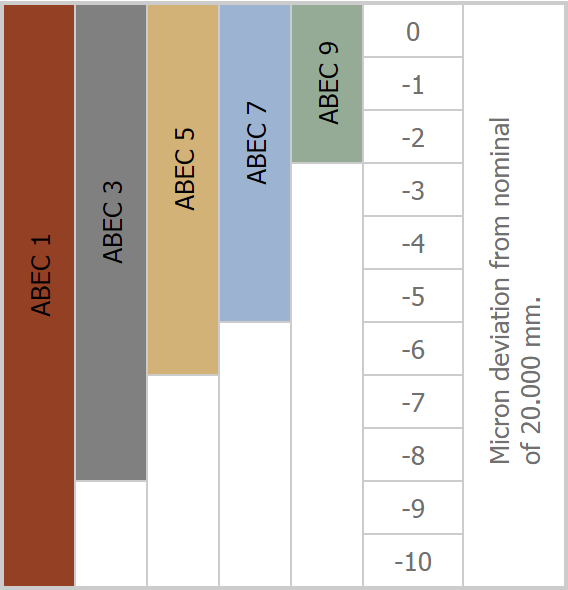|
ABEC Scale
The ABEC scale is an industry accepted standard for the tolerances of a ball bearing. It was developed by the Annular Bearing Engineering Committee (ABEC) of the American Bearing Manufacturers Association (ABMA). The ABEC scale is designed to provide bearing manufacturers dimensional specifications that meet the standards of precision bearings in a specified class. Manufacturers who produce equipment that require bearings must also know the dimensional tolerances to design parts that will accommodate a bearing. There are five classes from largest to smallest tolerances: 1, 3, 5, 7, 9. The higher ABEC classes provide better precision, efficiency, and the possibility of greater speed capabilities, but do not necessarily allow the components to spin faster. The ABEC rating does not specify many critical factors, such as load handling capabilities, ball precision, materials, material Rockwell hardness, degree of ball and raceway polishing, noise, vibration, and lubricant. Due to the ... [...More Info...] [...Related Items...] OR: [Wikipedia] [Google] [Baidu] |
Tolerance (engineering)
Engineering tolerance is the permissible limit or limits of variation in: # a physical dimension; # a measured value or physical property of a material, manufactured object, system, or service; # other measured values (such as temperature, humidity, etc.); # in engineering and safety, a physical distance or space (tolerance), as in a truck (lorry), train or boat under a bridge as well as a train in a tunnel (see structure gauge and loading gauge); # in mechanical engineering, the space between a bolt and a nut or a hole, etc. Dimensions, properties, or conditions may have some variation without significantly affecting functioning of systems, machines, structures, etc. A variation beyond the tolerance (for example, a temperature that is too hot or too cold) is said to be noncompliant, rejected, or exceeding the tolerance. Considerations when setting tolerances A primary concern is to determine how wide the tolerances may be without affecting other factors or the outcome o ... [...More Info...] [...Related Items...] OR: [Wikipedia] [Google] [Baidu] |
Skateboard
A skateboard is a type of sports equipment used for skateboarding. They are usually made of a specially designed 7-8 ply maple plywood deck and polyurethane wheels attached to the underside by a pair of skateboarding trucks. The skateboarder moves by pushing with one foot while the other foot remains balanced on the board, or by pumping one's legs in structures such as a bowl or half pipe. A skateboard can also be used by simply standing on the deck while on a downward slope and allowing gravity to propel the board and rider. If the rider's leading foot is their right foot, they are said to ride "goofy". The two main types of skateboards are the longboard and the shortboard. The shape of the board is also important: the skateboard must be concaved to perform tricks. History Skateboarding started in California in the 1950s. The first skateboards were made from roller skates attached to a board. Skateboarding gained in popularity because of surfing: in fact, skateboardi ... [...More Info...] [...Related Items...] OR: [Wikipedia] [Google] [Baidu] |
Japanese Industrial Standards
are the standards used for industrial activities in Japan, coordinated by the Japanese Industrial Standards Committee (JISC) and published by the Japanese Standards Association (JSA). The JISC is composed of many nationwide committees and plays a vital role in standardizing activities across Japan. History In the Meiji era, private enterprises were responsible for making standards, although the Japanese government too had standards and specification documents for procurement purposes for certain articles, such as munitions. These were summarized to form an official standard, the Japanese Engineering Standard, in 1921. During World War II, simplified standards were established to increase matériel output. The present Japanese Standards Association was established in 1946, a year after Japan's defeat in World War II. The Japanese Industrial Standards Committee regulations were promulgated in 1946, and new standards were formed. The Industrial Standardization Law was enac ... [...More Info...] [...Related Items...] OR: [Wikipedia] [Google] [Baidu] |
International Organization For Standardization
The International Organization for Standardization (ISO ) is an international standard development organization composed of representatives from the national standards organizations of member countries. Membership requirements are given in Article 3 of the ISO Statutes. ISO was founded on 23 February 1947, and (as of November 2022) it has published over 24,500 international standards covering almost all aspects of technology and manufacturing. It has 809 Technical committees and sub committees to take care of standards development. The organization develops and publishes standardization in all technical and nontechnical fields other than electrical and electronic engineering, which is handled by the IEC.Editors of Encyclopedia Britannica. 3 June 2021.International Organization for Standardization" ''Encyclopedia Britannica''. Retrieved 2022-04-26. It is headquartered in Geneva, Switzerland, and works in 167 countries . The three official languages of the ISO are English, F ... [...More Info...] [...Related Items...] OR: [Wikipedia] [Google] [Baidu] |
Revolutions Per Minute
Revolutions per minute (abbreviated rpm, RPM, rev/min, r/min, or with the notation min−1) is a unit of rotational speed or rotational frequency for rotating machines. Standards ISO 80000-3:2019 defines a unit of rotation as the dimensionless unit equal to 1, which it refers to as a revolution, but does not define the revolution as a unit. It defines a unit of rotational frequency equal to s−1. The superseded standard ISO 80000-3:2006 did however state with reference to the unit name 'one', symbol '1', that "The special name revolution, symbol r, for this unit is widely used in specifications on rotating machines." The International System of Units (SI) does not recognize rpm as a unit, and defines the unit of frequency, Hz, as equal to s−1. :\begin 1~&\text &&=& 60~&\text \\ \frac~&\text &&=& 1~&\text \end A corresponding but distinct quantity for describing rotation is angular velocity, for which the SI unit is the ... [...More Info...] [...Related Items...] OR: [Wikipedia] [Google] [Baidu] |
Industrial Machinery
The following outline is provided as an overview of and topical guide to industrial machinery: Essence of industrial machinery * Heavy equipment * Hardware * Industrial process * Machine * Machine tool * Tool Industrial machines * Agricultural equipment * Assembly line * Industrial robot * Oil refinery * Packaging and labeling * Paper mill * Sawmill * Smelter * Water wheel Industrial processes * Bessemer process * Food processing * Manufacturing * Mining * Packaging and labeling History of industrial machinery * History of agricultural machinery * History of assembly lines * History of the bessemer process * History of heavy equipment * History of industrial robots * History of machines * History of machine tools * History of oil refineries * History of packaging and labeling * History of paper mills * History of smelting * History of water wheels A water wheel is a machine for converting the energy of flowing or falling water into useful forms of powe ... [...More Info...] [...Related Items...] OR: [Wikipedia] [Google] [Baidu] |
Fishing Reel
A fishing reel is a hand-cranked reel used in angling to wind and stow fishing line, typical mounted onto a fishing rod, but may also be used to retrieve a tethered arrow when bowfishing. Modern recreational fishing reels usually have fittings aiding in casting for distance and accuracy, as well as controlling the speed and tension of line retrieval to avoid line snap and hook dislodgement. Fishing reels are traditionally used in angling and competitive casting. They are typically attached near the handle of a fishing rod, though some specialized reels with pressure sensors for immediate retrieval are equipped on downrigger systems which are mounted directly to an ocean-going sport boat's gunwales or transoms and are used for "deep drop" and trolling. The earliest fishing reel was invented in China at least since the Song dynasty, as shown by detailed illustration of an angler fishing with reel from Chinese paintings and records beginning about 1195 AD, although sporadic ... [...More Info...] [...Related Items...] OR: [Wikipedia] [Google] [Baidu] |
Roller Skates
Roller skates, are shoes or bindings that fit onto shoes that are worn to enable the wearer to roll along on wheels. The first roller skate was an inline skate design, effectively an ice skate with wheels replacing the blade. Later the "quad skate" style became more popular, consisting of four wheels arranged in the same configuration as a typical car. Roller skating is a hobby, sport, and mode of transportation using roller skates. History While the first reported use of wheeled skates was on a London stage in 1743, the first patented "roller skate" was introduced in 1760 by Belgian inventor John Joseph Merlin. They were hard to steer and stopping was difficult due to the fact that they did not have any type of braking mechanism and as such they failed to gain popularity. Merlin demonstrated his invention during a party in the city of Huy, during which he skated while playing the violin. In the 1840s, Meyerbeer's opera '' Le prophète'' featured a scene in which perfor ... [...More Info...] [...Related Items...] OR: [Wikipedia] [Google] [Baidu] |
Ball Bearing
A ball bearing is a type of rolling-element bearing that uses balls to maintain the separation between the bearing races. The purpose of a ball bearing is to reduce rotational friction and support radial and axial loads. It achieves this by using at least two races to contain the balls and transmit the loads through the balls. In most applications, one race is stationary and the other is attached to the rotating assembly (e.g., a hub or shaft). As one of the bearing races rotates it causes the balls to rotate as well. Because the balls are rolling they have a much lower coefficient of friction than if two flat surfaces were sliding against each other. Ball bearings tend to have lower load capacity for their size than other kinds of rolling-element bearings due to the smaller contact area between the balls and races. However, they can tolerate some misalignment of the inner and outer races. History Although bearings had been developed since ancient times, the first m ... [...More Info...] [...Related Items...] OR: [Wikipedia] [Google] [Baidu] |
Hobbies
A hobby is considered to be a regular activity that is done for enjoyment, typically during one's leisure time. Hobbies include collecting themed items and objects, engaging in creative and artistic pursuits, playing sports, or pursuing other amusements. Participation in hobbies encourages acquiring substantial skills and knowledge in that area. A list of hobbies changes with renewed interests and developing fashions, making it diverse and lengthy. Hobbies tend to follow trends in society, for example stamp collecting was popular during the nineteenth and twentieth centuries as postal systems were the main means of communication, while video games are more popular nowadays following technological advances. The advancing production and technology of the nineteenth century provided workers with more leisure time to engage in hobbies. Because of this, the efforts of people investing in hobbies has increased with time. Hobbyists may be identified under three sub-categories: ''c ... [...More Info...] [...Related Items...] OR: [Wikipedia] [Google] [Baidu] |
Vehicles
A vehicle (from la, vehiculum) is a machine that transports people or cargo. Vehicles include wagons, bicycles, motor vehicles (motorcycles, cars, trucks, buses, mobility scooters for disabled people), railed vehicles ( trains, trams), watercraft (ships, boats, underwater vehicles), amphibious vehicles ( screw-propelled vehicles, hovercraft), aircraft (airplanes, helicopters, aerostats) and spacecraft.Halsey, William D. (Editorial Director): ''MacMillan Contemporary Dictionary'', page 1106. MacMillan Publishing, 1979. Land vehicles are classified broadly by what is used to apply steering and drive forces against the ground: wheeled, tracked, railed or skied. ISO 3833-1977 is the standard, also internationally used in legislation, for road vehicles types, terms and definitions. History * The oldest boats found by archaeological excavation are logboats, with the oldest logboat found, the Pesse canoe found in a bog in the Netherlands, being carbon dated to ... [...More Info...] [...Related Items...] OR: [Wikipedia] [Google] [Baidu] |









